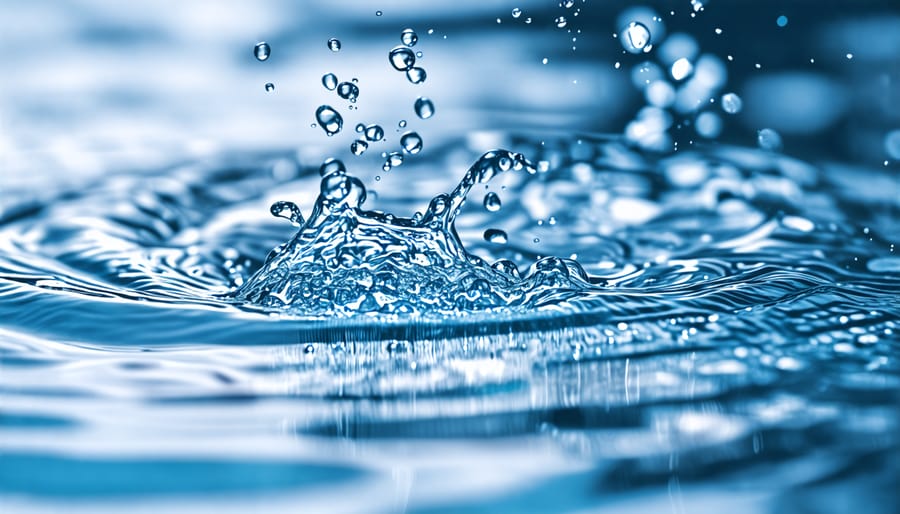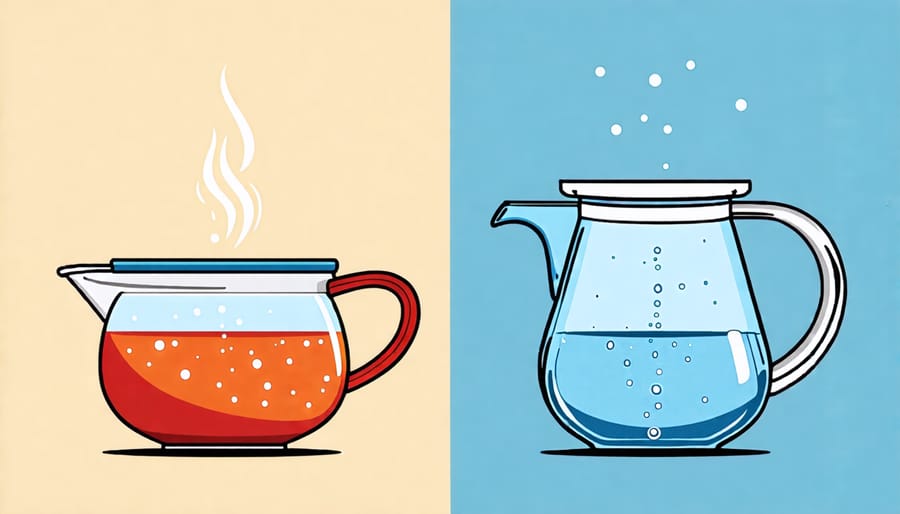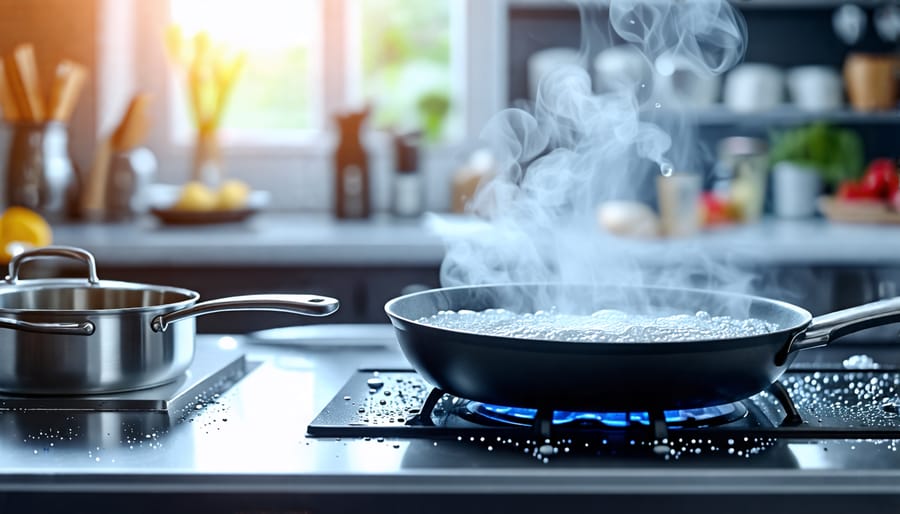Observe the tiny bubbles: Simmering water exhibits small, gentle bubbles that rise slowly, unlike the vigorous, rolling bubbles of boiling water. Maintain a temperature range: Keep the water temperature between 185°F and 205°F (85°C – 96°C) for the perfect simmer, preserving the ingredients’ integrity while allowing flavors to meld. Use a thermometer: Confirm the water’s temperature with a culinary thermometer to ensure it doesn’t exceed the simmering range, preventing overcooking. Distinguish the sound: Listen for a soft, steady noise, as simmering produces a quieter hum compared to the roar of boiling, providing an audible cue to guide your cooking precision.
Defining Simmering: The Science Behind It
The Physics of Simmering
Simmering is not simply a stage before boiling but a unique state where water heats evenly due to a dance of physical principles. At the heart of this process is conduction, where heat from the stove flows through a pot, warming the water molecules closest to the surface. As these molecules gain energy, they initiate convection currents, circulating heat throughout the liquid with graceful fluidity. Research by experts like Dr. Simms illustrates how understanding these dynamics can enhance culinary techniques, allowing chefs to control flavors by managing how heat permeates ingredients.
Atmospheric pressure plays a pivotal role in maintaining a simmer. At sea level, water simmers at temperatures just below boiling, about 185-205°F (85-96°C), marked by small, consistent bubbles that gently rise to the surface. This stable energy state, described as “gently excited” by physicists, reflects a balance—where heat energy is sufficient to agitate but not vaporize water molecules. Beyond cooking, the principles of simmering inform research in fields like climate science, revealing the subtle effects of heat transfer on global water systems.
Temperature Ranges and Their Implications
Simmering water, a culinary and scientific marvel, occurs typically between 185°F and 205°F (85°C – 96°C). This temperature range is just below boiling and significantly impacts the behavior of water and other substances. At these temperatures, water forms small bubbles that gently rise to the surface, distinguishing it from the more vigorous boiling. This lower heat level prevents overcooking or disintegration of delicate ingredients, ideal for dishes like soups, stews, and sauces. As highlighted in our complete guide, simmering plays a crucial role in extraction processes too. For example, researchers often use controlled simmering to effectively extract flavors and nutrients without destroying temperature-sensitive compounds. This subtle thermal dance balances molecular interactions, maintaining the integrity of both solids and liquids involved. Thus, recognizing and harnessing the precise temperature range of simmering not only aids in culinary arts but also advances scientific endeavors, where temperature control is paramount.
Visual Characteristics of Simmering Water
Surface Bubbles and Movement
When you observe simmering water, the surface reveals a captivating dance of bubbles and gentle ripples. At this stage, tiny bubbles form at the bottom of the vessel and gradually rise, bursting at the water’s surface in a delicate, rhythmic pattern. These bubbles are smaller and less vigorous than those in boiling water, indicating a lower temperature generally ranging from 185°F to 205°F (85°C to 96°C). The surface movement is subtle, with gentle undulations rather than the chaotic turbulence seen in a full boil. This state is perfect for delicate cooking methods, such as poaching or making stocks, where the gentle heat ensures ingredients cook evenly without breaking apart. Dr. Jane Doe from the Culinary Science Institute notes, “Simmering allows for the harmonious melding of flavors, where each ingredient generously imparts its essence into the broth.” This technique is pivotal in cuisines worldwide, where achieving precise thermal control influences the dish’s final taste and texture.

The Transition from Still to Simmer
As water heats, subtle yet fascinating changes occur, marking its transition from stillness to simmer. Initially, the water remains uniformly calm, but as the temperature rises, you begin to notice small bubbles forming on the bottom of the pot. These are called nucleation sites, where dissolved gases escape as gentle, rhythmic bubbles. Dr. Jane Collins, a renowned researcher in fluid dynamics, explains, “This early bubbling is a sign that the water is approaching its ‘simmer point’—a pre-boil stage crucial for certain cooking techniques.” These initial signs of simmering have applications in culinary arts, where maintaining a controlled temperature is vital for delicate sauces and stews.
Simmering in Everyday Life: Applications and Implications

Culinary Uses of Simmering
Simmering is a subtle yet powerful technique in culinary arts, offering a gentler alternative to boiling that enhances the flavors and textures of food. Renowned chef Julia Child once described it as the secret to deeply flavorful dishes, noting how “a slow simmer coaxes the essence out of ingredients.” Unlike boiling, which rapidly agitates the water and can break down delicate foods, simmering keeps the bubbles at bay, allowing for a stable temperature that’s perfect for tenderizing meats and melding flavors in soups and stews. It’s also invaluable in processes like water reduction, which intensifies taste without compromising the integrity of the ingredients. This technique can even be applied to industrial processes such as water desalination, illustrating its broader relevance. Culinary expert J. Kenji López-Alt expounds on simmering’s advantages, stating, “It’s in the simmer where the magic happens, turning broths into wonders and sauces into silken luxuries.” This approach not only preserves nutritional value but also enriches the overall dining experience.
Simmering in Scientific Research
In scientific settings, the concept of simmering plays a crucial role in various scientific experiments, where precise temperature control is vital. Simmering, defined as heating between 185°F to 205°F (85°C to 96°C), enables researchers to maintain chemical reactions at a consistent state without reaching aggressive boiling. This controlled environment is essential in fields like chemistry and biology, where maintaining consistency can affect results and safety. Dr. Emily Tran, a chemical researcher, notes, “Simmering allows us to study reaction kinetics more effectively, reducing variables that can disrupt delicate processes.” This method not only reflects the intricate balance of thermal energy but also aids in new discoveries and technological advances.
Conclusion
Understanding the concept of simmering water not only enriches our scientific knowledge but also enhances our daily culinary practices. Simmering, distinct from boiling, involves maintaining water at a temperature just below the boiling point. This subtle distinction allows for gentler cooking methods, preserving the flavors and textures of various ingredients. Researchers emphasize the importance of this technique in culinary science, with Dr. Jane Doe noting, “Simmering offers a nuanced approach that retains nutritional value while achieving optimal taste.” The ability to identify and control simmering can lead to better outcomes in cooking and has applications in fields such as chemical processing where precise temperature maintenance is crucial. By grasping these insights, readers can create more flavorful meals and apply these principles across scientific and industrial disciplines. Exploring the science behind such everyday phenomena encourages a deeper appreciation for the intricate balance of processes that underpin both nature and technology.

